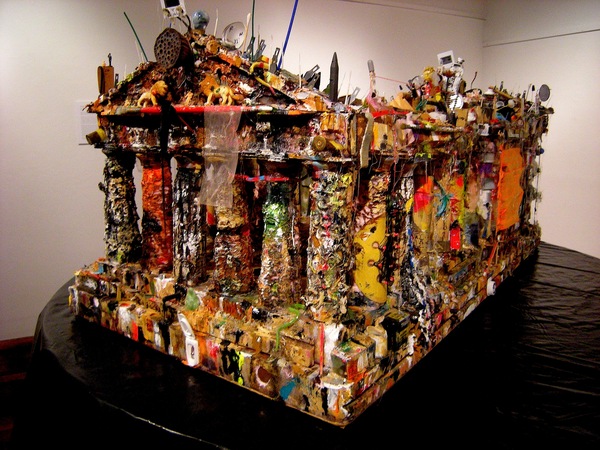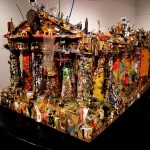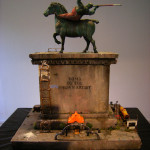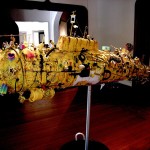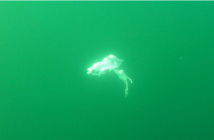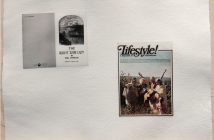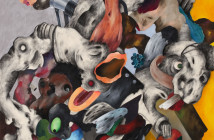When asked his opinion of Western civilization, Gandhi famously replied that he thought it would be a good idea. Peter Waite¹s sculptures are evidence of it being a bad one.
These are miniatures of the frenzy beneath our fantasies of order, something like the munching swirl of ghastly insects just below the surface of the manicured lawns in David Lynch¹s Blue Velvet suburb. Although the label commentary for the piece entitled Temple makes the obviously clever suggestion that its colorful mishmash is closer to what the Greek original would have looked like (though not in the case of its putative inspiration at Segesta in Sicily, which was never actually completed), the work is more powerfully read as the accretions of our present, rather than some brightly graffittied rendering of the past. Here are countless adoptions and misreadings, those civic mimicries of 19th century banks and courthouses, with all their ornamented injustice and economic violence. And here is the artist bought and sold in the den of thieves, a plastic snake looking for a way out, like the sacred serpent that legendarily slithered away from the temple precincts just before glorious Athens filled with barbarians.
Parked inside several of the arcade vaults beneath the Amphitheater, abandoned vending trucks with their tire tracks precisely incised, are all that remain of some poverty stricken la dolce vita experiment. The bleachers, strewn with fingernail parings whose transformed scale suggest the remains of some bored giant, are empty, save for an indifferent dog which one needs a curator¹s directions to find. But no crowd is necessary. Instead, a small mirror fragment upright on the stage is a reminder that the artist¹s only certain audience in this indifferent world is the artist¹s solitary, furious self.
But Waite sees to it that comedy always keeps company with rage. The is a vaudeville grandeur attached to each of these assemblages. As clustered and seething as the Monster from the Deep appears, there are no accidents in its arrangement. The Beatles perambulate through holes in the hull, affirming the ship¹s yellow lineage. But there is still the aura of the conveniently forgotten threat attached to such machines. At this very moment, they are out there, carrying the end of the world around and around in the sea.
It is curious that the more overtly political argument of the piece There Will Be Rust, with its punning title, oil derrick and drive-in Matisse exhibit registers as forced and self-conscious, while Babel, with its Golden Children¹s Bible pictorialism literally stood on its head, makes the misguided madness of human technology and its tiny creators absolutely and laughably clear.
Waite¹s continual self-reference in these works never registers as either arrogance or solipsism. He knows the limits of his own perception, human as they are, yet revels in them. His sculpted portraits from 2004, Self/Good and Self/Bad, which suggest zombie versions of the anthropomorphic moles from The Wind in the Willows or Walt Kelly¹s Pogo, are amused dopplegängers, completely at ease with the disarray which results from their mutual dependency. Tomb redefines the monumental equestrian excess usually granted to revised emperors as a struggling artist¹s just due. The rites of fabrication are all that matter, even when the medium is muck. And behind Waite¹s Death Ship, a carnival version of Bertolt Brecht¹s ³black freighter² in its gaudy tribute to mortality, a wake of photographic slides catalogs the artist's oeuvre floating away. Is it true, then, that all we leave behind is fragile and unnoticed?
There is, as I remember it, a model in the cellar of Sir John Soane¹s Museum in London, which renders Soane¹s design for the Bank of England as a significant ruin to come. It imagines the future as simply the disguised wreckage of the past. And that, as Waite exuberantly reports, is exactly where we are now.
- Peter Waite, Temple, 2008. Mixed media: studio detritus, paint scrapings, found objects, personal artifacts, junk, etc.
- Peter Waite, Tomb, 2008. Mixed media: studio detritus, paint scrapings, found objects, personal artifacts, junk, etc.
"Peter Waite, Parallel Play: Sculpture/Fetish/Object/Things" is on view through July 25, 2010 at John Slade Ely House located in New Haven, CT.
All images are courtesy of the artist and author.

